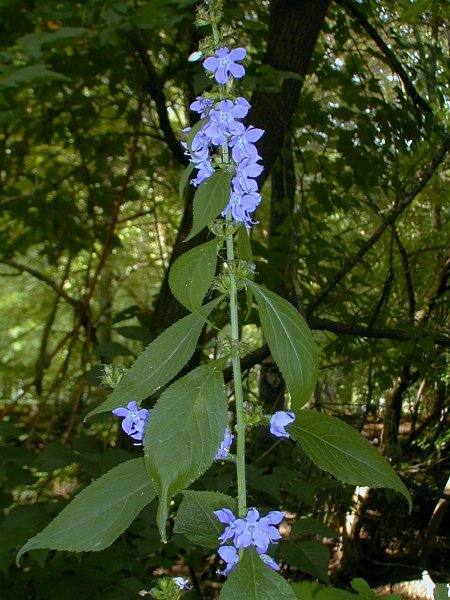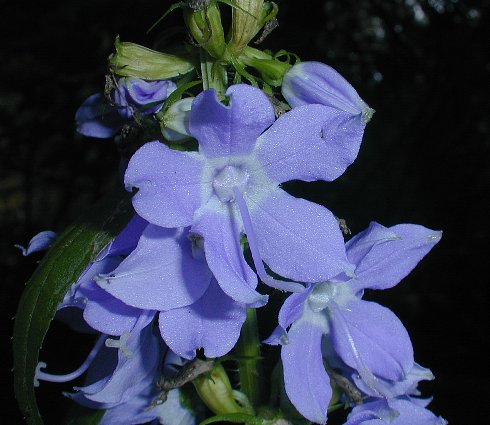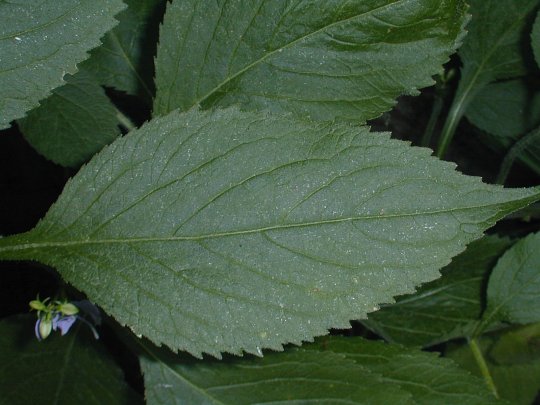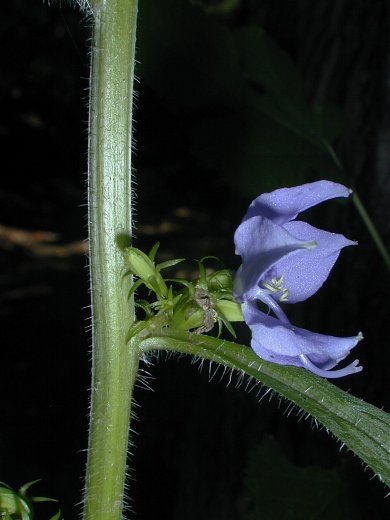Description: This plant is an annual or biennial from 2-6' tall. Usually, it is unbranched, although sometimes a few side stems will develop from the lower central stem. The central stem is light green, terete, slightly grooved, and hairy. The alternate leaves are up to 6" long and 2" across, tapering to slender petioles. They are medium to dark green, elliptic to ovate in shape, and their margins are serrated. The texture of the leaves is somewhat rough; they are hairy along the major veins of their undersides. The central stem terminates in a spike of flowers about ½–2' long. From the axils of the upper leaves, secondary spikes of flowers may develop, but these are much shorter (about 1–6" in length). The rachis (central stalk) of each spike is similar to the central stem. The flowers are about 1" across; their corollas vary in color from light to dark violet-blue, depending on the local ecotype.

Each corolla has 5 spreading lobes that are divided nearly to the base; they are ovate to obovate in shape. Each corolla has a satiny appearance under bright light, and it tends to have margins that twist and curl. The corolla is often white toward the center, rather than blue-violet. At the center of the corolla is the apex of a 5-angled ovary from which a light violet style is strongly exerted. This style bends downward from the flower, but curls upward near its tip; the small stigma is white and divided into 3 lobes. Each flower also has 5 stamens. The light green calyx is tubular-campanulate in shape with 5 narrow green ridges and 5 long narrow teeth around its upper rim; these teeth curl backward when the flower opens. The blooming period occurs from mid-summer to early fall, lasting about 1½ months. Afterwards, the flowers are replaced by seed capsules that are 5-angled and rather flat-topped. The root system consists of a taproot.

Cultivation:
The
preference is light shade to partial sun, moist to mesic conditions,
and a rich loamy soil. During a drought, this plant often drops its
lower leaves. Depending on moisture conditions and the fertility of the
soil, the size of this plant can be highly variable.
Range & Habitat:
American Bellflower is a common plant that occurs in most counties of
Illinois (see Distribution
Map), where it is native. Habitats include moist to slightly
dry deciduous woodlands, disturbed open woodlands, woodland borders,
and thickets. This plant is often found along woodland paths, and it
appears to prefer slightly disturbed areas.

Faunal
Associations: Long-tongued bees are
the primary pollinators of the flowers, including bumblebees
and leaf-cutting bees (Megachilidae). Among the latter, is the
oligolectic bee Megachile campanulae campanulae.
Other visitors of the flowers include Halictid bees, butterflies, and
skippers. These insects seek nectar, and some of the bees collect
pollen from the anthers. Syrphid flies may feed on the pollen, but they
are not effective pollinators. Deer occasionally eat the flowers and
foliage.
Photographic Location:
The edge of a wooded area at Crystal Lake Park in Urbana, Illinois.

Comments: Sometimes this plant is called "Tall Bellflower." The older scientific name is Campanula americana, but it has been reassigned to its own genus because of the unique structure of the flowers. The flowers of this tall-growing plant are showy, but individually short-lived. However, new flowers are produced in succession higher up on the spike. The other members of the Bellflower family that occur in Illinois, whether native or introduced, have bell-shaped (campanulate) flowers, while the flowers of the American Bellflower have a more open design with widely spreading lobes. As a result, this species is easy to identify.